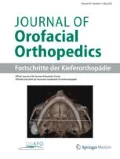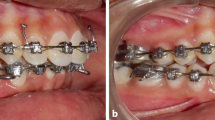Abstract
Purpose
To investigate the skeletal, dental, and soft tissue effects of reverse Forsus (RF; 3M Unitek, Monrovia, CA, USA) and facemask/rapid palatal expansion (FM/RPE) appliances in growing subjects with class III malocclusions.
Methods
The data of this prospective randomized controlled trial (RCT) were derived from pre- and posttreatment/observation lateral cephalograms of 45 subjects with mild class III malocclusions: group 1 (8 girls, 7 boys; mean age 10.54 years) received a FM/RPE appliance; group 2 (6 girls, 9 boys; mean age 10.49 years) received the RF appliance; and an untreated control group (7 girls, 8 boys; mean age 10.66 years) was matched to the treatment groups with regard to sagittal skeletal and dental classifications. Angular and linear measurements were evaluated using lateral cephalograms. Statistical analyses were performed by one-way analysis of variance, Kolmogorov–Smirnov test, Kruskal–Wallis, paired-samples t‑test, and Wilcoxon test, whereby p < 0.05 was accepted to be statistically significant.
Results
The intermaxillary (ANB), interdental (overjet), and sagittal lip relations in the FM/RPE and RF groups showed significant improvements compared to the control group (p < 0.05). Although the anterior and inferior traction of the maxilla was greater in the FM/RPE group compared to the RF group (p < 0.05), both treatment groups showed similar clockwise rotation of the mandible compared to the control group. While significantly more proclination of maxillary incisors occurred in the RF group compared to the FM/RPE and control groups (p < 0.05), both treatments led to significantly retroclined mandibular incisors compared to the control group (p < 0.001).
Conclusion
Both therapies led to intermaxillary and interdental improvements. The RF appliance had a limited effect on the maxilla and it mostly had dentoalveolar effects when compared to FM/RPE therapy.
Zusammenfassung
Zielsetzung
Untersucht werden sollten die skelettalen, dentalen und weichgewebigen Auswirkungen zweier Apparaturen – Reverse Forsus (RF; 3M Unitek, Monrovia, CA, USA) und Gesichtsmaske/Gaumennahterweiterung (FM/RPE) – bei heranwachsenden Patienten mit Klasse-III-Malokklusionen
Methoden
Die Daten für diese prospektive, randomisierte, kontrollierte Studie (RCT) wurden aus seitlichen Kephalogrammen vor und nach der Behandlung/Beobachtung von 45 Probanden mit leichten Klasse-III-Fehlstellungen gewonnen: Gruppe 1 (8 Mädchen, 7 Jungen; Durchschnittsalter 10,54 Jahre) erhielt eine FM/RPE-Apparatur, Gruppe 2 (6 Mädchen, 9 Jungen; Durchschnittsalter 10,49 Jahre) eine RF-Apparatur, und eine unbehandelte Kontrollgruppe (7 Mädchen, 8 Jungen; Durchschnittsalter 10,66 Jahre) war hinsichtlich der sagittalen skelettalen und zahnmedizinischen Klassifikationen an die Behandlungsgruppen angepasst. Winkel- und Längenmaße wurden anhand von lateralen Kephalogrammen ausgewertet. Statistische Analysen wurden mittels einseitiger Varianzanalyse, Kolmogorov-Smirnov-Test, Kruskal-Wallis, t‑Test für gepaarte Stichproben und Wilcoxon-Test durchgeführt, wobei p < 0,05 als statistisch signifikant akzeptiert wurde.
Ergebnisse
Die intermaxillären (ANB), interdentalen (Overjet) und sagittalen Lippenrelationen in der FM/RPE- und RF-Gruppe zeigten signifikante Verbesserungen im Vergleich zur Kontrollgruppe (p < 0,05). Zwar war die anteriore und inferiore Traktion des Oberkiefers in der FM/RPE-Gruppe größer als in der RF-Gruppe (p < 0,05), aber beide Behandlungsgruppen zeigten eine ähnliche Posteriorrotation des Unterkiefers im Vergleich zur Kontrollgruppe. Während in der RF-Gruppe im Vergleich zur FM/RPE- und zur Kontrollgruppe eine signifikant stärkere Proklination der Oberkieferschneidezähne auftrat (p < 0,05), führten beide Behandlungen zu signifikant retroklinierten Unterkieferschneidezähnen im Vergleich zur Kontrollgruppe (p < 0,001).
Schlussfolgerung
Beide Therapien führten zu intermaxillären und interdentalen Verbesserungen. Die RF-Apparatur hatte einen begrenzten Effekt auf den Oberkiefer und im Vergleich zur FM/RPE-Therapie hauptsächlich dentoalveoläre Effekte.





Similar content being viewed by others
References
Ellis E III, McNamara JA Jr (1984) Components of adult class III malocclusion. J Oral Maxillofac Surg 42:295–305
Sanborn RT (1955) Differences between the facial skeletal patterns of class III malocclusion and normal occlusion. Angle Orthod 25:208–222
Macdonald KE, Kapust AJ, Turley PK (1999) Cephalometric changes after the correction of class III malocclusion with maxillary expansion/facemask therapy. Am J Orthod Dentofacial Orthop 116:13–24
Mandall N, DiBiase A, Littlewood S, Nute S, Stivaros N, McDowall R et al (2010) Is early class III protraction facemask treatment effective? A multicentre, randomized, controlled trial: 15-month follow-up. J Orthod 37:149–161
Seiryu M, Ida H, Mayama A, Sasaki S, Sasaki S, Deguchi T et al (2020) A comparative assessment of orthodontic treatment outcomes of mild skeletal class III malocclusion between facemask and facemask in combination with a miniscrew for anchorage in growing patients: a single-center, prospective randomized controlled trial. Angle Orthod 90:3–12
Şar Ç, Arman-Özçırpıcı A, Uçkan S, Yazıcı AC (2011) Comparative evaluation of maxillary protraction with or without skeletal anchorage. Am J Orthod Dentofacial Orthop 139:636–649
Campbell PM (1983) The dilemma of class III treatment: early or late? Angle Orthod 53:175–191
Zymperdikas VF, Koretsi V, Papageorgiou SN, Papadopoulos MA (2016) Treatment effects of fixed functional appliances in patients with class II malocclusion: a systematic review and meta-analysis. Eur J Orthod 38:113–126
Vogt W (2006) The forsus fatigue resistant device. Journal of clinical orthodontics. J Clin Orthod 40:368
Martina R, D’Antò V, De Simone V, Galeotti A, Rongo R, Franchi L (2020) Cephalometric outcomes of a new orthopaedic appliance for class III malocclusion treatment. Eur J Orthod 42:187–192
Rakosi T III (1997) Treatment of class III malocclusions. Dentofacial orthopedics with functional appliances. CV Mosby, pp 461–480
Hassel B, Farman AG (1995) Skeletal maturation evaluation using cervical vertebrae. Am J Orthod Dentofacial Orthop 107:58–66
Van Acker J, Pauwels N, Cauwels R, Rajasekharan S (2020) Outcomes of different radioprotective precautions in children undergoing dental radiography: a systematic review. Eur Arch Paediatr Dent 21:463–508
Björk A, Skieller V (1983) Normal and abnormal growth of the mandible. A synthesis of longitudinal cephalometric implant studies over a period of 25 years. Eur J Orthod 5:1–46
Seehra J, Fleming PS, Mandall N, Dibiase AT (2012) A comparison of two different techniques for early correction of class III malocclusion. Angle Orthod 82:96–101
Dahlberg G (1940) Statistical methods for medical and biological students. Statistical methods for medical and biological students
Ngan P, Hägg U, Yiu C, Merwin D, Wei SH (1996) Soft tissue and dentoskeletal profile changes associated with maxillary expansion and protraction headgear treatment. Am J Orthod Dentofacial Orthop 109:38–49
Arman A, Toygar TU, Abuhijleh E (2004) Profile changes associated with different orthopedic treatment approaches in class III malocclusions. Angle Orthod 74:733–740
Cozza P, Marino A, Mucedero M (2004) An orthopaedic approach to the treatment of class III malocclusions in the early mixed dentition. Eur J Orthod 26:191–199
Ucem TT, Ucuncu N, Yuksel S (2004) Comparison of double-plate appliance and facemask therapy in treating class III malocclusions. Am J Orthod Dentofacial Orthop 126:672–679
Kapust AJ, Sinclair PM, Turley PK (1998) Cephalometric effects of face mask/expansion therapy in class III children: a comparison of three age groups. Am J Orthod Dentofacial Orthop 113:204–212
Gencer D, Kaygisiz E, Yüksel S, Tortop T (2015) Comparison of double-plate appliance/facemask combination and facemask therapy in treating class III malocclusions. Angle Orthod 85:278–283
Chen L, Chen R, Yang Y, Ji G, Shen G (2012) The effects of maxillary protraction and its long-term stability—a clinical trial in Chinese adolescents. Eur J Orthod 34:88–95
Gallagher R, Miranda F, Buschang P (1998) Maxillary protraction: treatment and posttreatment effects. Am J Orthod Dentofacial Orthop 113:612–619
Shanker S, Ngan P, Wade D, Beck M, Yiu C, Hägg U et al (1996) Cephalometric A point changes during and after maxillary protraction and expansion. Am J Orthod Dentofacial Orthop 110:423–430
Ngan P, Hagg U, Yiu C, Merwin D, Wei SH (1996) Treatment response to maxillary expansion and protraction. Eur J Orthod 18:151–168
Baccetti T, Franchi L, McNamara JA Jr (2000) Treatment and posttreatment craniofacial changes after rapid maxillary expansion and facemask therapy. Am J Orthod Dentofacial Orthop 118:404–413
Tortop T, Keykubat A, Yuksel S (2007) Facemask therapy with and without expansion. Am J Orthod Dentofacial Orthop 132:467–474
Vaughn GA, Mason B, Moon H‑B, Turley PK (2005) The effects of maxillary protraction therapy with or without rapid palatal expansion: a prospective, randomized clinical trial. Am J Orthod Dentofacial Orthop 128:299–309
Atilla AO (2007) Comparison of the effects face mask application during or after rapid maxillary expansion on maxillary and mandibular structures in growing children with class III malocclusion. SDÜ Sağlık Bilimleri Enstitüsü,
Kajiyama K, Murakami T, Suzuki A (2000) Evaluation of the modified maxillary protractor applied to class III malocclusion with retruded maxilla in early mixed dentition. Am J Orthod Dentofacial Orthop 118:549–559
Smith SW, English JD (1999) Orthodontic correction of a class III malocclusion in an adolescent patient with a bonded RPE and protraction face mask. Am J Orthod Dentofacial Orthop 116:177–183
Ngan P, Yiu C, Hu A, Hagg U, Wei SH, Gunel E (1998) Cephalometric and occlusal changes following maxillary expansion and protraction. Eur J Orthod 20:237–254
Merwin D, Ngan P, Hagg U, Yiu C, Wei SH (1997) Timing for effective application of anteriorly directed orthopedic force to the maxilla. Am J Orthod Dentofacial Orthop 112:292–299
Lombardo EC, Franchi L, Lione R, Chiavaroli A, Cozza P, Pavoni C (2020) Evaluation of sagittal airway dimensions after face mask therapy with rapid maxillary expansion in class III growing patients. Int J Pediatr Otorhinolaryngol 130:109794
Kim J‑H, Viana MA, Graber TM, Omerza FF, BeGole EA (1999) The effectiveness of protraction face mask therapy: a meta-analysis. Am J Orthod Dentofacial Orthop 115:675–685
Eissa O, ElShennawy M, Gaballah S, ElMehy G, El-Bialy T (2018) Treatment of class III malocclusion using miniscrew-anchored inverted forsus FRD: controlled clinical trial. Angle Orthod 88:692–701
Türkiye Atom Enerjisi Kurumu (2018) Homepage. http://www.taek.gov.tr/belgeler-formlar/mevzuat/kanunlar/TAEK-Kanunu/. Accessed 6 July 2018
European Union, European Commission (2004) Radiation protection 136. European guidelines on radiation protection in dental radiology. Office for Official Publications of the EC, Luxembourg
Khiroya R (2013) Dose optimisation in contemporary digital lateral cephalometry. University of Birmingham, Birmingham
Author information
Authors and Affiliations
Corresponding author
Ethics declarations
Conflict of interest
M.A. Yavan, A. Gulec and M. Orhan declare that they have no competing interests.
Ethical standards
All procedures performed in studies involving human participants or on human tissue were in accordance with the 1975 Helsinki declaration and its later amendments or comparable ethical standards. This study was approved by the ethics committee of Gaziantep University (2015/180). Written informed consent for publication was obtained from the patients or their parents/legally authorized representatives (LAR) in the case of individuals under 18.
Additional information
Publisher’s Note
Springer Nature remains neutral with regard to jurisdictional claims in published maps and institutional affiliations.
Rights and permissions
About this article
Cite this article
Yavan, M.A., Gulec, A. & Orhan, M. Reverse Forsus vs. facemask/rapid palatal expansion appliances in growing subjects with mild class III malocclusions. J Orofac Orthop 84, 20–32 (2023). https://doi.org/10.1007/s00056-021-00330-1
Received:
Accepted:
Published:
Issue Date:
DOI: https://doi.org/10.1007/s00056-021-00330-1




